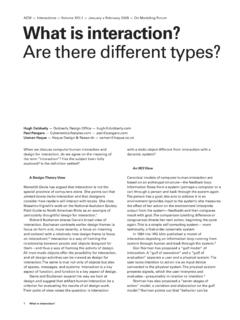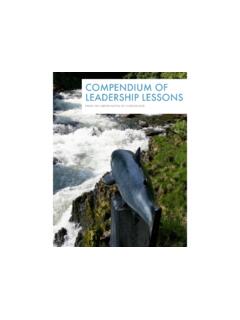Transcription of (OWDOYOUDESIGN
1 (OW DO YOU DESIGN ! #OMPENDIUM OF -ODELSBY (UGH $UBBERLY$UBBERLY $ESIGN /FFICE (ARRISON 3 TREET 3AN &RANCISCO #! Everyone teacherarranging desksfor a entrepreneurplanning a teambuilding a results do their do the scales of their projectsand the media they their actionsappear quite s similaris that they are s similarare the processesthey processesdetermine the qualityof our we wish to improve our products,we must improve our processes;we must continually redesignnot just our productsbut also the way we s why we study the design know what we doand how we do understand itand improve become better this book, I have collected over one-hundred descriptions of design and development processes, from architecture, industrial design, mechanical engineering, quality management, and software development.)))
2 They range from short mnemonic devices, such as the 4Ds (defi ne, design, develop, deploy), to elaborate schemes, such as Archer s 9-phase, 229-step systematic method for designers. Some are synonyms for the same process; others represent differing approaches to design. By presenting these examples, I hope to foster debate about design and development do we design? Why do we do it that way?How do we describe what we do?Why do we talk about it that way?How do we do better?Asking these questions has practical goals:- reducing risk (increasing the probability of success)- setting expectations (reducing uncertainty and fear)- increasing repeatability (enabling improvement)Examing process may not benefi t everyone. For an individual designer imagine someone working alone on a poster focusing on process may hinder more than it helps.
3 But teaching new designers or working with teams on large projects requires us to refl ect on our process. Success depends on: - defi ning roles and processes in advance- documenting what we actually did- identifying and fi xing broken processesAd hoc development processes are not effi cient and not repeatable. They constantly must be reinvented making improvement nearly impossible. At a small scale, the costs may not matter, but large organizations cannot sustain this discussion, more subtle questions also arise:How do we minimize risk while also maximizing creativity?When must we use a heavy-weight process?And when will a light-weight process suffi ce?What is the place of interaction design within the larger software development process?
4 What is the place of the software development process within the larger business formation processes?What does it mean to conceive of business formation as a design process?7 OriginsThe oldest development process model I ve seen dates from about 1920 and describes how to develop a battleship for the Royal Navy. Discussions about design and development processes began in earnest shortly after the second world war. They grew out of military research and development efforts in at least three fi elds, operations research, cybernetics, and large-scale engineering project management. Pre-war efforts to make radar an effective part of the British air-defense system led to operations research, which then matured into an academic discipline.
5 Development of automatic piloting devices and fi re-control systems for aiming large guns led to servo-mechanisms and computing devices, anticipating the emergence of cybernetics, one of the roots of artifi cial intelligence. Large engineering projects undertaken during the war and later cold-war projects, such as the Atlas and Titan missile projects, demanded new techniques to deal with increased scale and complexity. The excitement of these new disciplines and the success of these huge engineering projects captivated many people. From operations research, cybernetics, and large-scale engineering project management, academic designers imported both methods and philosophy in what became known as the design methods movement (1962-1972).
6 Work in the UK, at Ulm in Germany, and MIT and Berkeley in the US sought to rationalize and systemize the design process. Several designers attempted to codify the design process and present it as a scientifi c parallel efforts occurred in the business world. Stafford Beer and others applied systems thinking and especially operations research to business problems. During the 1950s, W. Edward Deming examined business processes. His work led to the quality management movement, which became popular in Japan and something of a fad in the US in the 1980s. Its principles became standard operating procedures in much of the business world, becoming enshrined in ISO and six-sigma standards. In the software world, interest in the development process dates back at least to the IBM System 360, released in 1964.
7 In 1975, Fred Brooks, manager of OS/360, published The Mythical Man Month, his belated answer to [IBM Chairman] Tom Watson s probing question as to why programming is so hard to manage. Today, software developers are still actively discussing the question. Consultants seek to differentiate themselves with proprietary processes. Software tools makers seek standards around which they can build tools a new twist on codifying the design ties exists between the design methods world and the software development world. One of the founders of the design methods movement, Christopher Alexander, co-wrote A Pattern Language. Alexander s work on design patterns in architecture contributed to thinking on design patterns in software. In the 1970s, another important fi gure in the movement, Horst Rittel, developed IBIS (Issues-Based Information System) to support the design process.
8 Rittel s research into IBIS is a precursor of today s work on design rationale. But for the most part, designers, business managers, and software developers appear to be unaware of practices and thinking about process in the other disciplines. Even within their own fi elds, many are unaware of much prior fi elds overlap, but so far as I know, no one has attempted to bring together work from these three areas. One of my goals is to cast each of these activities as design, to show how their processes are similar, and to encourage sharing of ideas between the twiceCut onceLab studyPilot plantFull-scale plantResearchDevelopmentManufacturingSal esReadyAimFire9 ContentsThe carpenter s adage, the captain s command, the chemical engineer s scale-up process, the corporation s departments the four phrases on the previous page have something in common.
9 Each is a sequence of steps. Each is a process focused on achieving a goal. Each suggests iteration and convergence. Each is an analog of the design book presents many other descriptions of design and development processes. I call these descriptions design process models, distinguishing the description from the activity it describes. I also combine design and development into one category, because the distinction is without a collection is not exhaustive. Even so, organizing it presents a challenge. At the end of the book are indices organized by title, date, and author. In the body of the book are threads but no strong narrative. I have paired models where I see a connection. These pairings and the entire structure are idiosyncratic.
10 Thus, the book is more a reference work than a Introducing process19 Analysis versus synthesis29 Academic models61 Consultant models 67 Software development82 Complex linear models115 Cyclic models132 Complete list of models136 Chronological list140 Author list10 Design processafter Tim Brennan (~1990)At an off-site for Apple Computer s Creative Services de-partment, Tim Brennan began a presentation of his group s work by showing this model. Here s how we work, he said. Somebody calls up with a project; we do some stuff; and the money follows. Brennan captures important aspects of the process:- the potential for play- its similarity to a random walk - the importance of iteration - its irreducible black-box nature Introducing processWhat is a process?










